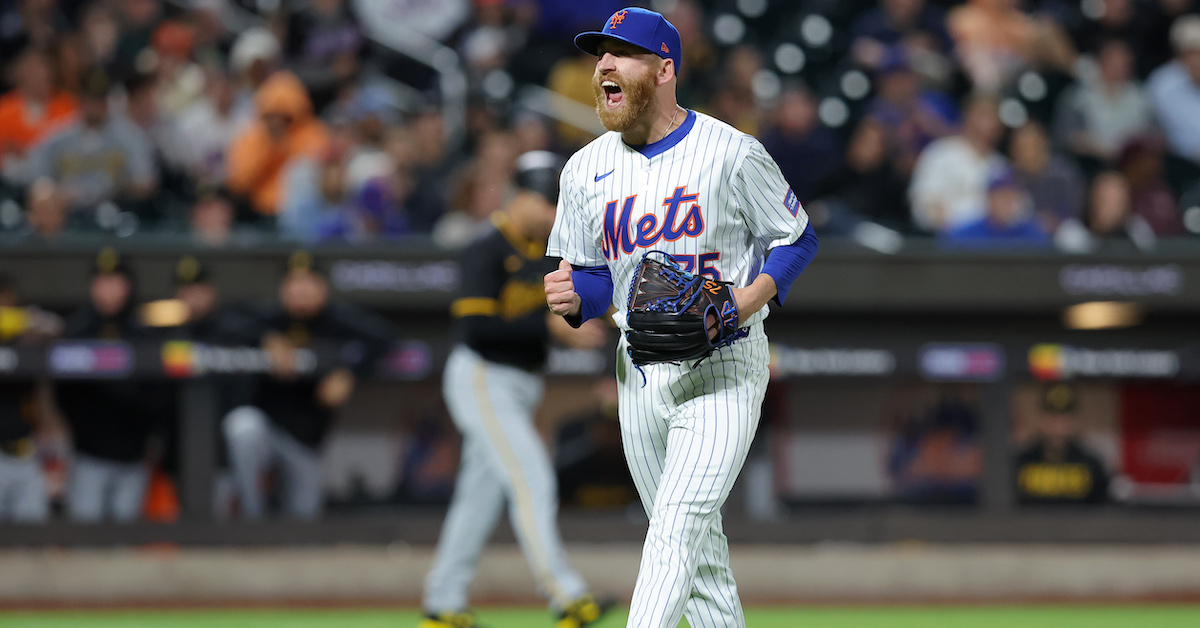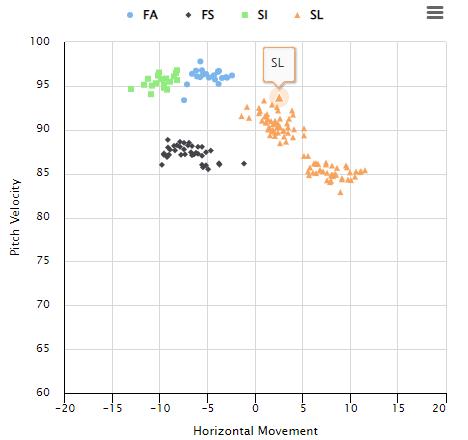
Brad Penner-USA TODAY Sports
C’mon now. You don’t really believe in Reed Garrett. Honestly, you might not even know who he is unless you’re a Mets fan or really into interchangeable middle relievers. Garrett debuted for the Tigers in 2019, tossing 15.1 forgettable innings. He departed for Japan and pitched for the Seibu Lions for two years, where he was good but not great. Upon returning to the states, he delivered more of the same: nine bad major league innings for the Nats in 2022, 20 split between the Orioles and Mets in 2023, and plenty of minor league time mixed in.
Some of that minor league time was fairly good. Garrett struck out 28% of opponents while pitching for the Norfolk Tides, the Triple-A affiliate of the Orioles, in 2023, though he walked 10% there and 14.5% in his time with the Mets. He posted a 1.59 ERA there, too, though it came with an unsustainable 91.9% left-on-base rate. He even looked fairly decent for the Nats in Triple-A in 2022, recording a 3.04 ERA in 47.1 innings with a 27% strikeout rate. We listed him on our Positional Power Ranking bullpen preview — as the 11th reliever out of New York’s bullpen, with a projected ERA of 4.75.
Garrett has thrown only 10.2 innings since then, which doesn’t sound like enough to change opinions of anyone. But my, oh my, have they been good innings. Let me just put it this way: We now project his ERA the rest of the way at 4.07, a drop of nearly three quarters of a run. Imagine how good someone has to be in less than 11 innings to outweigh their entire career up to that point. Garrett has faced only 41 batters this year; 21 of them have struck out. Ah, yeah, that’ll do it.
How’s he doing it? With a big pile of junk, more or less, and I mean that as a compliment. Garrett throws two fastballs, but he throws them a mere 25% of the time combined. If you look at our player page, you’ll see that his pitch summary includes 54% sliders and 22% splitters. But even that doesn’t quite explain it. The “slider” category is broad. Here’s a chart of pitch velocity and horizontal movement that makes it clear what’s going on:

Garrett has two options with his slider. He throws a hard version of the pitch that sits around 90 mph with minimal glove-side break, as well as a sweeping version that lives in the mid-80s and breaks significantly more. The sweeping one has a ton of variation, as you can see from the movement chart.
The hard, gyro slider is acting like a de facto fastball. He throws it in the zone and early in counts or when he’s fallen behind. It’s his most common pitch in 0-0, 1-0, 2-0, 1-1, 2-1, and 3-1 counts. If you think of it like a cutter, you’ll get most of the way there, but it’s a good cutter. The shape and velocity, combined with the fact that recognizing spin doesn’t completely solve the equation given that he has two different sliders, have produced a raft of takes and feeble swings even when hitters do identify it.
The sweeping variation, new last year, is why this works as well as it does. It looks like a hard slider until it slips sideways, and its lower velocity (5.6 mph on average) means that it falls an additional nine inches in flight. See one slider early in the count and take, see another late in the count and chase. It’s a rough bind.
Oh, you want to see it in action? That’s fair. Here’s a hard slider early in the count:
And a bendy one late:
Both of his sliders have produced much better results in the strike zone, because batters are having trouble identifying which is which, resulting in a ton of takes. As you’d expect, pitches taken for strikes are good for pitchers. No one has a lower in-zone swing rate against their sliders this year, which is convenient because he throws a lot of them for strikes.
When he throws either slider outside the zone, it doesn’t grade out particularly well, because opponents aren’t swinging at it very often. Again, they’re not swinging at any sliders, so the ones that miss are particularly unlikely to entice any action. But when hitters do swing, they’re coming up completely empty, and I do mean completely. They’ve swung 10 times (look, it’s a small sample) and missed nine of them. The only non-whiff was a harmless foul ball. Goodness gracious:
When Garrett isn’t modulating between sliders, he’s using the other new trendy pitch: a splitter. His is a classic off-speed offering, and he’s using it at roughly twice his previous career rate this year. Why? Because it’s the best the pitch has ever been. Some offseason tweaks have added sideways and downward movement while keeping velocity roughly constant. The new version of the pitch is half a tick slower than last year’s, but it falls 2.2 more inches and fades an additional 2.1 inches to his arm side. That’s turned it from a show-me option to an out pitch:
His fastballs certainly exist, but that’s about the most I can say about them. He throws them sparingly, as a change of pace to his secondaries-first approach. If you’ve seen a bunch of slow and weirdly-moving pitches all at-bat, a fastball might cross you up and lead to an ill-advised take. But there’s a problem with this approach: Garrett can’t throw his fastball for a strike. He’s thrown 40 this year, and 11 have been in the strike zone.
That’s unfathomably bad, last in the league out of 438 pitchers who have thrown at least 25 fastballs bad. And this has been a problem for him, though not to this extent, since his return to the states. Of the 636 pitchers who have thrown at least 300 fastballs over the past three years, Garrett has the second-lowest zone rate, ahead of only Corbin Burnes, who doesn’t really count; he mainly throws a cutter and shoots up the list if I include that instead of just sinkers and four-seamers.
To recap: Garrett can’t throw his fastball for a strike. Strangely, he can throw his slider for a strike. Among 239 pitchers who have thrown at least 25 sliders this year, Garrett is sixth in zone rate at 65.4%. He’s 14th in sweeper zone rate at 56.1%. This isn’t a one-year fluke; he’s second in the majors in slider zone rate from 2022 onward. Zone rate is at least partially a matter of intent, so throwing strikes is not a perfect metric of command, but if you can put your slider in the strike zone twice as often as your fastball, maybe don’t throw any fastballs, huh?
It’s not like hitters are coming into this with no idea what’s going on. He threw sliders 45% of the time last year and looked extremely average. But adding a good splitter to the mix is stretching hitters in an additional direction, and it’s paying dividends so far. Previously, with no fastball (more or less) and an ineffective off-speed pitch, everything Garrett threw moved the same way. Hitters do pretty well at that kind of thing. But now that there’s a blurry slider continuum to deal with, and also a splitter that drops off the table, it’s a lot to keep track of.
I absolutely don’t think that Garrett is going to keep this up. He’s striking out half the batters he faces and hasn’t allowed a run, after all. But I do think that this new approach has unlocked his best self. He really shouldn’t throw many fastballs. He really should lean on his hard slider early in counts. He really does need a third pitch, and a splitter is the perfect option there.
Let me put it this way: Across the majors, pitchers have drawn called strikes on 16.9% of their pitches so far this year. It’s been stable between 16.4% and 16.9% for the last decade. In his previous major league seasons, Garrett got called strikes 13.1% of the time. He couldn’t locate in the zone! He started missing a ton of bats last year, but if you can’t get ahead in the count with called strikes, whiffs don’t help as much.
This year, his called strike rate is up to 18.7%. I don’t think it will stay that high – he’s gotten some generous calls already, and hitters will inevitably start to swing more – but if that number stabilizes around league average, he’s going to be a good reliever. He throws 75% secondaries, after all, and bat-missing ones at that. He’s going to rack up strikeouts this way.
When teams cycle through relievers on the waiver wire, they’re not hoping to find the next Josh Hader. That guy would never be on waivers, because he was obviously good right from the jump. Instead, they’re looking for someone who has good tools but who needs a tweak or two to make things work. Think Yennier Cano with the Orioles last year, or pretty much anyone in the Rays bullpen at any given moment.
That’s more or less what’s going on here, I think. Garrett’s skills are maximized when he uses his slider as a primary and complements it with a good non-slider secondary. I think he’s here to stay, not as a dominant reliever but as an above average option. Not bad for a guy who struggled to stick in the big leagues for so long.
Source
https://blogs.fangraphs.com/allow-me-to-convince-you-to-believe-in-reed-garrett/
 Backyard GrillingWeekend WarriorsAdvice from DadBeard GroomingTV Shows for Guys4x4 Off-Road CarsMens FashionSports NewsAncient Archeology World NewsPrivacy PolicyTerms And Conditions
Backyard GrillingWeekend WarriorsAdvice from DadBeard GroomingTV Shows for Guys4x4 Off-Road CarsMens FashionSports NewsAncient Archeology World NewsPrivacy PolicyTerms And Conditions
